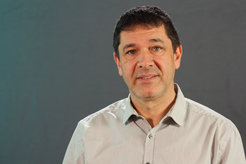Dr. Stanislav Balouchev

Stanislav Balouchev studied Laser Physics at the Sofia University "St.Kliment Ochridski", Bulgaria, where he received his M.Sci. in 1990. In 1995 he finished his PhD in the field of dark spatial solitons at the Quantum Electronics and Laser Physics Department, Sofia University. In 1996, he was granted a DAAD- research fellowship and spent a year in the group of Prof. Dr. Bernd Wellegehausen, Institute of Quantum Optics, Hannover University, Germany. Since 1995 he has also been affiliated as assistant professor in the Technical University Sofia, Bulgaria. In 1997 he was visiting scientist at the Institute of Experimental Physics, Technical University of Graz, Austria in the group of Prof. Dr. Laurentius Windholz. In 1999 he was granted a Feinberg research fellowship at the Department of Complex Systems, Weizmann Institute of Science, Rehovot, Israel in the group of Prof. Dr. Nir Davidson. In 2000 he started his Maria-Curie fellowship in the group of Prof. F. Riehle at PTB, Braunschweig, Germany. In 2001, he joined the group of Prof. Dr. Gerhard Wegner at MPI-P. In 2008 he joined the group of Prof. Dr. Katharina Landfester at MPI-P, as a leader of the photophysical chemistry group. In 2009 he habilitates at Optics and Spectroscopy Department, Faculty of Physics, Sofia University, Bulgaria. In 2014 he started his FCFP Senior Fellowship at Freiburg Institute for Advanced Studies (FRIAS, research focus “Quantum Transport”), Albert-Ludwigs-Universität Freiburg, Germany.
Research interests
His research interests include nonlinear optics, atomic physics including coherent population trapping and laser cooling. His current research topic is focused on the energy transport in optically created densely populated organic triplet ensembles, including the phenomenon of triplet-triplet annihilation photon energy upconversion (TTA-UC) and its application in the field of sunlight engineering and energy storage. Merging the techniques of annihilation upconversion and miniemulsion polymerization leads to creation of ultimate sensing tools: Recently, a minimally invasive all-optical sensing technology, based on nano-encapsulated TTA-UC active materials for real-time control of the local temperature and oxygen content in malignant cell cultures was demonstrated.
